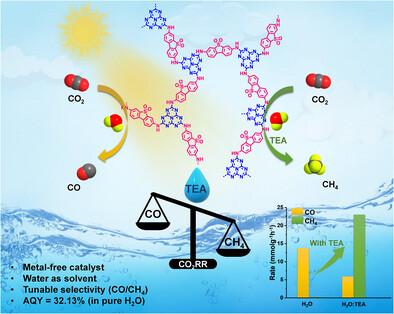水中选择性CO2光还原的砜功能化共价七嗪聚合物网络:牺牲供体依赖选择性的机理见解
IF 19
1区 材料科学
Q1 CHEMISTRY, MULTIDISCIPLINARY
引用次数: 0
摘要
减少二氧化碳排放和开发可持续能源替代品的迫切需要推动了光催化二氧化碳减排的广泛研究。本研究报道了一种合理设计的砜功能化共价七嗪聚合物网络(HSF)在纯水中实现了高效、选择性的CO2光还原。砜单元的引入增强了光生电荷分离,优化了CO2吸附,改善了质子化性能,在可见光照射下,纯水的CO产率显著提高,选择性达99%。在λ = 400 nm处获得了极高的表观量子产率(AQY),达到32.13%,这是迄今为止报道的任何无金属光催化剂的最高表观量子产率。有趣的是,通过引入三乙胺(TEA)作为牺牲电子供体,产物选择性从CO转向CH4,达到80%的CH4选择性。现场瞬态吸收光谱和密度泛函理论(DFT)计算的机理揭示了砜部分在促进载流子动力学和调节CO2吸附构型方面起着关键作用。此外,TEA不仅具有空穴清除剂的作用,还具有质子转移剂的作用,可以实现有效的质子化,并将*CO逐步还原为CH4。本文章由计算机程序翻译,如有差异,请以英文原文为准。

Sulfone-Functionalized Covalent Heptazine Polymeric Networks for Selective CO2 Photoreduction in Water: Mechanistic Insights into Sacrificial Donor-Dependent Selectivity
The urgent need to mitigate CO2 emissions and develop sustainable energy alternatives has driven extensive research into photocatalytic CO2 reduction. In this study, a rationally designed sulfone-functionalized covalent heptazine polymeric networks (HSF) that achieves highly efficient and selective CO2 photoreduction in pure water is reported. The introduction of sulfone units enhances photogenerates charge separation, optimizes CO2 adsorption, and improves protonation properties, leading to a remarkable CO production rate in pure water with >99% selectivity under visible light irradiation. An exceptionally high apparent quantum yield (AQY) of 32.13% at λ = 400 nm has been achieved- the highest ever reported to date for any metal-free photocatalyst. Intriguingly, by introducing triethylamine (TEA) as a sacrificial electron donor, the product selectivity shifts from CO to CH4, achieving 80% CH4 selectivity. Mechanistic insights from in situ transient absorption spectroscopy and density functional theory (DFT) calculations reveal that the sulfone moiety plays a pivotal role in facilitating charge carrier dynamics and modulating the adsorption configuration of CO2. Furthermore, it shows that TEA not only acts as a hole scavenger but also functions as a proton transfer agent, enabling efficient protonation and the stepwise reduction of *CO to CH4.
求助全文
通过发布文献求助,成功后即可免费获取论文全文。
去求助
来源期刊

Advanced Functional Materials
工程技术-材料科学:综合
CiteScore
29.50
自引率
4.20%
发文量
2086
审稿时长
2.1 months
期刊介绍:
Firmly established as a top-tier materials science journal, Advanced Functional Materials reports breakthrough research in all aspects of materials science, including nanotechnology, chemistry, physics, and biology every week.
Advanced Functional Materials is known for its rapid and fair peer review, quality content, and high impact, making it the first choice of the international materials science community.
 求助内容:
求助内容: 应助结果提醒方式:
应助结果提醒方式:


